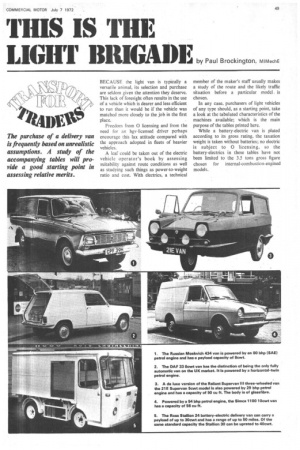THIS IS THE
Page 51

If you've noticed an error in this article please click here to report it so we can fix it.
LIGHT BRIGADE by Pau Brockington, MIMechE
BECAUSE the light van is typically a versatile animal, its selection and purchase are seldom given the attention they deserve. This lack of foresight often results in the use of a vehicle which is dearer and less efficient to run than it would be if the vehicle was matched more closely to the job in the first place.
Freedom from 0 licensing and from the need for an hgv-licensed driver perhaps encourage this lax attitude compared with the approach adopted in fleets of heavier vehicles.
A leaf could be taken out of the electric vehicle operator's book by assessing suitability against route conditions as well as studying such things as power-to-weight ratio and cost. With electrics, a technical member of the maker's staff usually makes a study of the route and the likely traffic situation before a particular model. is chosen.
In any case, purchasers of light vehicles of any type should, as a starting point, take a look at the tabulated characteristics of the machines available; which is the main purpose of the tables printed here.
While a battery-electric van is plated according to its gross rating, the taxation weight is taken without batteries; no electric is subject to 0 licensing, so the battery-electries in these tables have not been limited to the 3.5 tons gross figure chosen for internal-combustion-engined models.
















































































































































